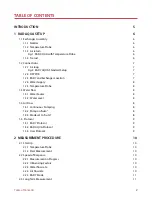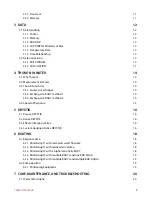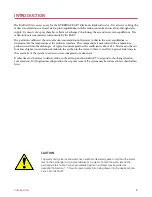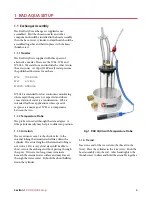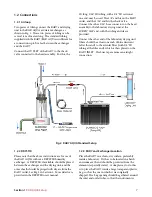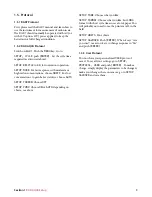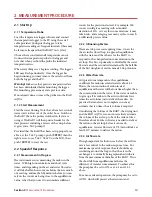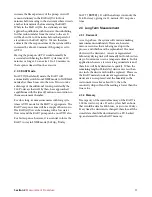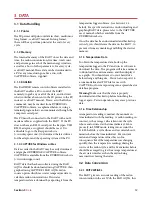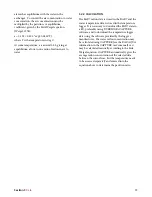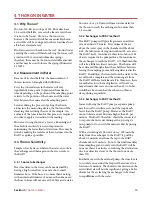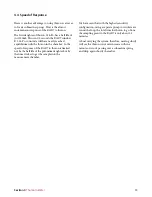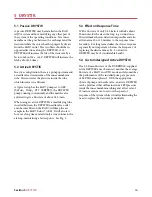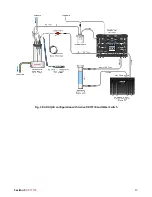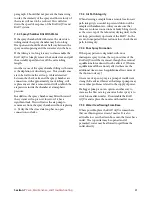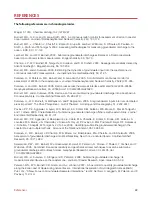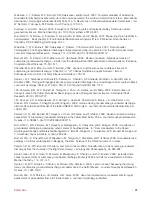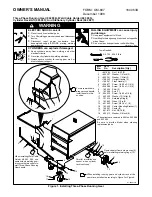
inside a closed space, completely protected from the
elements, while still allowing observation of the LCD
and print-out, and operation of the key pad.
Th
e exchanger unit may be placed upright in a sink,
or higher than a boat’s gunwales. Water will
fl
ow
from the hose outlet, in the base of the exchanger. A
garden hose may be connected to the exchanger base,
to take the out
fl
ow, provided it runs downhill from
the exchanger.
1.2.4 Water Supply
Th
e water supply should be connected to the two
large hose connectors in the head assembly. If the
supply will be at high pressure, then clamps may be
necessary around the water tubing, to hold the tubes
on.
For a slow-response application, where water
conservation is important, one nozzle can be sealed
with a cap over the hose connector and water
supplied only to the other one.
1.2.5 Temperature Probe
Th
e temperature probe should be inserted down the
stem adapter as far as it will go. A little Vaseline
smeared on the sha
ft
will help it go in more easily,
and will also ensure an air-tight
fi
tting.
Th
e probe
should be plugged into the temperature data logger,
which should be put in its own plastic bag to protect
it, once it has been launched.
1.3 Water Flow
1.3.1 Water Source
Th
e water entering the instrument should come
direct from the sampling point, below the surface,
and should not have been exposed to any air-water
interface en route.
Th
e water should be clean and
free from debris. If necessary, it should be
fi
ltered
(but not with charcoal) before entering the exchanger.
Th
e preferred delivery system is a submerged pump,
delivering the water at fairly low pressure, straight
from the sampling point to the exchanger.
Th
ree
sizes of spray nozzle are supplied.
Th
e choice will
depend on the pump performance and the speed of
response required.
1.3.2. Water Level
With the water
fl
owing, a spray will be observed
inside the body of the exchanger. Water will
accumulate inside the base and over
fl
ow out through
the hose connector(s). If the
fl
ow rate is very high it
may be necessary to utilize both hose connectors.
Th
e level may also start to rise too high inside the
body of the exchanger. To correct, either reduce the
fl
ow rate or purchase the optional 12” cylinder. A
high water level inside the exchanger is no problem
provided it is no more than 1/3 of the way up the
exchanger and is stable.
If the water level rises slowly but continuously up the
cylinder it will be due to the water source being
completely without dissolved air. To correct this a
bleed may be added to the return air path from the
RAD7. It should be a long piece of tubing open at
one end and connected with a T-connector to the
tubing between the head assembly and the check
valve.
1.4 Air Flow
1.4.1 Continuous Pumping
If you choose “
SETUP, PUMP, ON [ENTER]
” and
“
SETUP, MODE, SNIFF [ENTER]
”, then the pump
will run continuously, regardless of the length of the
cycles, or status of the RAD7, and the RAD7 will
count only 218-Po decays. In this operational mode,
the system will have the fastest response time, but
desiccant is quickly hydrated.
1.4.2 Pump on “Auto”
Th
e pump, in auto operation, pumps for
fi
ve minutes
at the beginning of every cycle and then for one
minute in every
fi
ve.
Th
e length of each cycle is
chosen by the user. Short cycle times will involve
more pumping and speed up the response of the
instrument, but will consume more desiccant. Longer
cycle times will give better statistical precision to the
individual readings, and will conserve desiccant and
memory space.
For rapidly changing concentrations of radon in the
water, 10 minute cycles, with the PUMP on AUTO
and MODE on SNIFF, may be a suitable compromise,
though not giving fastest response.
1.4.3 Mode set to “Auto”
For very low concentrations, or when long-term
monitoring is desired, long cycle times of an hour or
longer, with the PUMP and MODE set to AUTO,
may make good sense.
Section 1
RAD AQUA Setup
8


